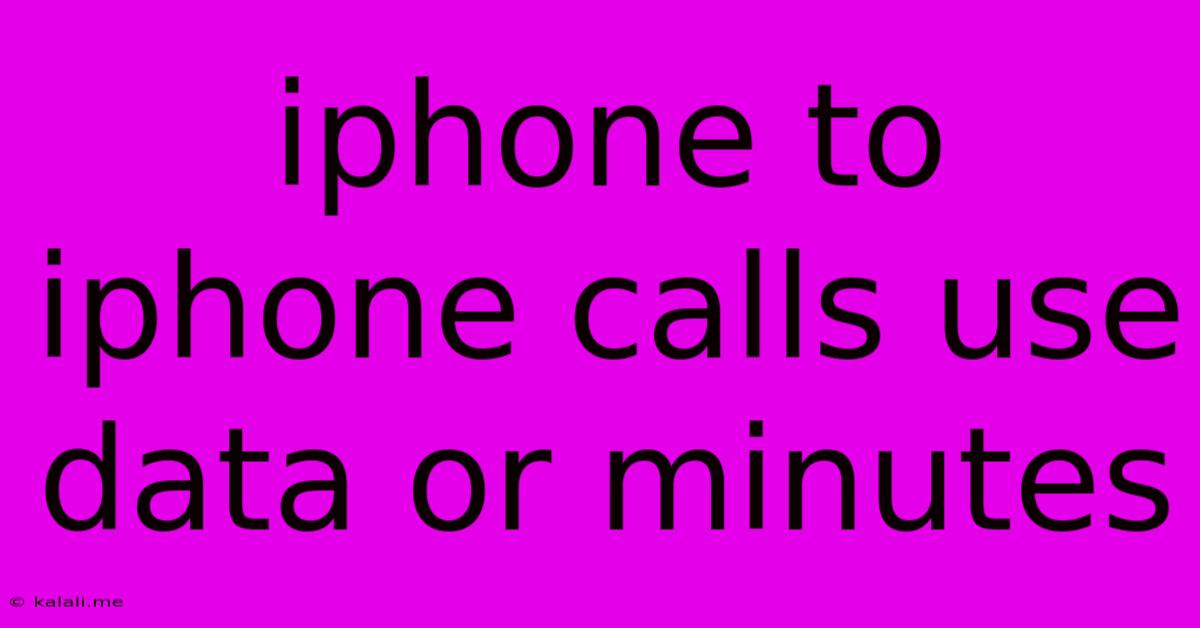Iphone To Iphone Calls Use Data Or Minutes
Kalali
Jun 04, 2025 · 3 min read

Table of Contents
iPhone to iPhone Calls: Data or Minutes? Understanding iMessage and FaceTime
Are you unsure whether calls between iPhones use your cellular minutes or data? The answer isn't always straightforward, as it depends on the calling method you're using. This comprehensive guide will clarify how iPhone-to-iPhone calls function, detailing the differences between using iMessage and FaceTime and helping you manage your cellular plan effectively.
Understanding the Two Main Calling Methods
There are primarily two ways to make calls between iPhones: using iMessage and using FaceTime. Both offer advantages, but their impact on your cellular data and minutes differs significantly. This distinction is crucial for understanding your phone bill. Choosing the right method can significantly reduce your data usage or conserve your precious minutes.
iMessage Calls (Over Wi-Fi or Cellular Data)
iMessage is Apple's integrated messaging service. While primarily known for text messages, it also supports voice and video calls. These calls, often called iMessage calls, utilize your device's internet connection – either Wi-Fi or cellular data. This means they do not use your cellular minutes. However, they will consume data from your mobile data plan.
- Key Features: High-quality audio, easy to initiate within the Messages app, uses internet connection.
- Data Usage: Consumes mobile data if not connected to Wi-Fi. Consider enabling Wi-Fi calling to reduce data usage.
- Minutes Usage: Does not consume cellular minutes.
FaceTime Calls (Over Wi-Fi or Cellular Data)
FaceTime is Apple's video calling app, but it also facilitates audio-only calls. Similar to iMessage calls, FaceTime calls also rely on an internet connection (Wi-Fi or cellular data) and therefore do not use your cellular minutes. The quality of the call might be better than iMessage calls, particularly for video. FaceTime audio calls are a solid alternative for longer conversations compared to iMessage.
- Key Features: High-quality audio and video, easy to initiate from the FaceTime app or contact list.
- Data Usage: Consumes mobile data if not connected to Wi-Fi. Again, Wi-Fi calling is your friend here.
- Minutes Usage: Does not consume cellular minutes.
Optimizing Your iPhone Calls for Data Savings
To minimize data usage when making iPhone-to-iPhone calls:
- Prioritize Wi-Fi: Always connect to a reliable Wi-Fi network before making calls. This will completely eliminate data consumption.
- Check Data Usage Settings: Regularly monitor your data usage in your iPhone's settings. This helps you track consumption and identify potential areas for improvement.
- Use High-Quality Audio Wisely: While convenient, high-quality audio and video calls consume more data than basic calls. Be mindful of your usage, especially when on a limited data plan.
- Consider Data Saver Mode: Enabling low power mode on your iPhone may limit some background data, which can indirectly impact calls by slightly reducing their quality.
In Conclusion:
Whether you're using iMessage or FaceTime, calls between iPhones use your data plan, not your cellular minutes. This is a significant benefit, especially if you have limited minutes in your plan. By understanding the difference and optimizing your usage with Wi-Fi, you can make the most of your iPhone calling experience while effectively managing your data allowance. Always remember to monitor your data usage to avoid unexpected charges.
Latest Posts
Latest Posts
-
How To Fix Screw Holes In Wood
Jun 06, 2025
-
How To Remove A Door Lever
Jun 06, 2025
-
How Do You Type A Book Title
Jun 06, 2025
-
Can One Of 3 Phases Be A Different Voltage
Jun 06, 2025
-
How Much Garlic Powder Equals 3 Cloves
Jun 06, 2025
Related Post
Thank you for visiting our website which covers about Iphone To Iphone Calls Use Data Or Minutes . We hope the information provided has been useful to you. Feel free to contact us if you have any questions or need further assistance. See you next time and don't miss to bookmark.